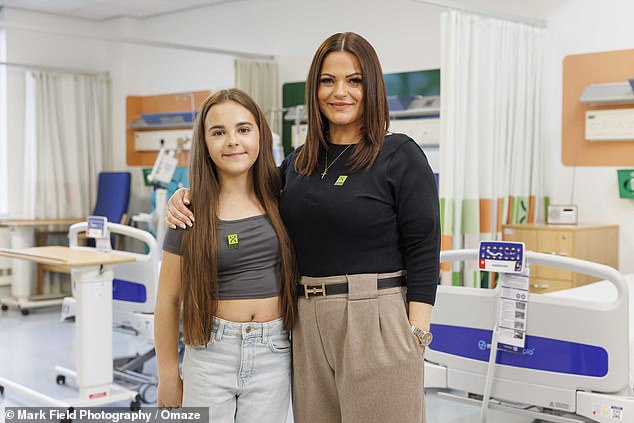Sofia Gardella’s favourite pastimes are swimming, riding her bike and spending time with her friends. Yet Sofia, 11, wouldn’t be enjoying these simple pleasures today had it not been for a lifesaving stem cell transplant nine years ago.
Her parents, Claire and Fabio, were devastated to learn their baby daughter had a rare and life-threatening genetic disorder.
A midwife spotted tiny marks on baby Sofia’s arms and legs, ‘a bit like birthmarks, but purpley’, says Claire, 43, an occupational therapist, who lives in Mansfield, Nottinghamshire, with Fabio, also 43, who works in sales, and their daughters, Sofia, and Sienna, 15. Blood tests revealed the marks on her skin were caused by an extremely low level of platelets (meaning blood cannot clot properly) – and this was caused by a condition called congenital amegakaryocytic thrombocytopenia (CAMT), which meant her body produced too few bone marrow cells needed to make platelets.
CAMT can be life-threatening because patients are at risk of bleeding spontaneously, even from a minor knock. The condition can also progress to affect other types of blood cells, including the white blood cells needed to fight off infections – meaning even ‘mild’ illnesses can become lethal.
‘It was a total shock particularly as Sofia didn’t look poorly at all,’ says Claire.
Sofia needed urgent chemotherapy to wipe out her faulty bone marrow (the spongy tissue inside the bones that plays a crucial role in producing blood cells), followed by a stem cell transplant from a donor to encourage the growth of healthy bone marrow.
Without this treatment, Sofia’s bone marrow would stop functioning by the time she was five – which could be fatal. ‘We were told that there was a 90 per cent chance of treatment being successful – but we were very worried that they wouldn’t be able to find a donor,’ says Claire.
When family members were found not to be a sufficiently good tissue match, doctors scoured national and international registers to find another suitable donor.

Sofia, 11, with her mum Claire at the new Anthony Nolan Cell Collection Centre in Nottingham
It was the stem cell charity Anthony Nolan that struck proverbial gold, finding a match in Germany: a woman in her 40s.
But the family had to wait another ‘agonising’ year until doctors deemed Sofia ready for a stem cell transplant at the age of two.
‘The next year was full of anxiety,’ says Claire. ‘Sofia was being closely monitored and we didn’t know if she would even survive the transplant.’ Claire recalls her excitement when the transplant day arrived in 2016, and she watched the courier arrive at hospital with the donated stem cells for Sofia.
‘I saw the courier pull up with the box,’ she says. ‘When the nurse brought the box into Sofia’s room and opened it up, there was what looked like a bag of blood inside – we told Sofia it was a bag of magic cells.’
For Sofia the treatment has been transformative. But others aren’t so lucky – for while demand for stem cell donations is rocketing, supply is not keeping up.
Tragically, some people die waiting – and not just because of a lack of suitable donors. In fact, 2.3 million people are on the UK registry to be stem cell donors.
The problem is that, once a match is identified, a donor would be invited to attend a hospital or independent centre with specialist equipment to take the donation – but there aren’t enough of these to keep up with demand. Only one in five donors on the UK registry were able to donate on the date requested in 2022-23 because of capacity issues, according to data collected by Anthony Nolan.
‘Sometimes, a collection centre may not be able to offer a slot for two or three months as they are already fully booked,’ says Dr Lilian Hook, director of cell, apheresis and gene therapies at NHS Blood and Transplant.
Such a wait may be catastrophic for the patient who needs the transplant. ‘Often, these are very sick people – and if they have to wait a couple of months more they may become too ill to undergo a transplant,’ says Dr Hook.
‘Unfortunately, patients sometimes deteriorate and may even die while waiting for a stem cell transplant,’ adds Dr Chloe Anthias, a haematologist and stem cell transplant consultant at The Royal Marsden Hospital in London. ‘All collection centres are at capacity and we badly need more slots. It’s almost at crisis point.’
The lack of facilities, coupled with a need for young donors with high-quality stem cells, means 70 per cent of stem cell transplants in the UK involve imported cells.
‘Many come from Germany, where there is an extensive stem cell register and where donors often have a good tissue match to UK patients,’ says Dr Hook. But this is complicated to organise and ‘expensive’, she says.
Demand for stem cell transplants has risen by a third in ten years – from around 3,800 in 2013 to just under 5,000 in 2023 (the last year for which figures are available).
This is partly because of improvements meaning the procedure is now suitable for more patients, but also because the use of stem cells has been vastly extended.
Traditionally, stem cell transplants were used to treat blood cancers, such as leukaemia and myeloma. But they are now also used for blood disorders, such as sickle cell anaemia (where abnormally shaped red blood cells form that may block blood vessels) and rarer conditions, such as CAMT for which previously there were few treatments, says Dr Anthias.
Increasingly, stem cells are being modified, too, for cancer and gene therapies. One such treatment, CAR T-cell therapy, involves harvesting and reprogramming a patient’s own blood cells to fight certain blood cancers.
‘All of these treatments require cell collection services, however,’ says Dr Anthias, who is a donor consultant at Anthony Nolan.

The Omaze Cheshire house can be won in the draw which closes at midnight on July 27
Giving stem cells is not as straightforward as giving blood. The donor receives injections of a hormone to stimulate the release of stem cells into the blood. Blood is then drawn from one arm using a special machine, which separates and collects the stem cells – and returns the rest of the blood to the other arm. In a minority of cases, stem cells are taken from bone marrow in a procedure that requires a general anaesthetic.
There’s no delay in getting them to the patient, says Dr Hook. ‘The main problem lies with finding a suitable donor and collecting the cells.’ But the situation looks set to improve, thanks to the new Anthony Nolan Cell Collection Centre, which opens this summer in Nottingham.
The centre, which will benefit from funds raised by the ongoing Omaze Cheshire house draw, is the first in the UK dedicated entirely to cell collection for patients needing stem cell transplants and gene therapies. Omaze sells tickets for a draw to win a glamorous house somewhere around the country – previous draws have raised funds for other health charities.
The new Anthony Nolan Cell Collection Centre, run in partnership with Nottingham University Hospitals NHS Trust, aims to provide 1,300 new cell collection slots a year, and will also conduct research into new cell therapies.
The exact amount received by the centre will depend on how much the draw raises, but Anthony Nolan is guaranteed to receive at least £1 million – enough to keep the centre running for six months.
Meanwhile, NHS Blood and Transplant is also expanding its cell collection capacity and is trying to recruit more donors.
Men under 30 are particularly sought as donors because men, generally being bigger, produce more stem cells – and the younger the donor, the more effective they are. Donors from mixed and minority ethnic backgrounds are also needed because it can be harder to find a tissue match for them, says Dr Hook.
Stem cell transplants are not without risks. Sofia developed graft-versus-host disease, where the donated cells attack a patient’s own cells, after her first transplant in 2016. She needed steroids to combat it, which caused fluid to build in her brain, affecting her memory. She needed a second stem cell transplant in 2018 because her platelet levels began to drop again.
‘At one stage I wondered if she would ever get better,’ says Claire. But now Sofia’s platelet levels are normal. She needs extra help at school and takes penicillin to protect her from infections – but the family counts their blessings.
‘I am just happy I can finally do normal things,’ says Sofia.
Claire adds: ‘We are so grateful for Sofia’s transplant – it’s wonderful to know that a new centre may help so many patients and families like ours.’
Entries for the Omaze draw in Cheshire close at midnight on July 27. To enter visit omaze.co.uk.












